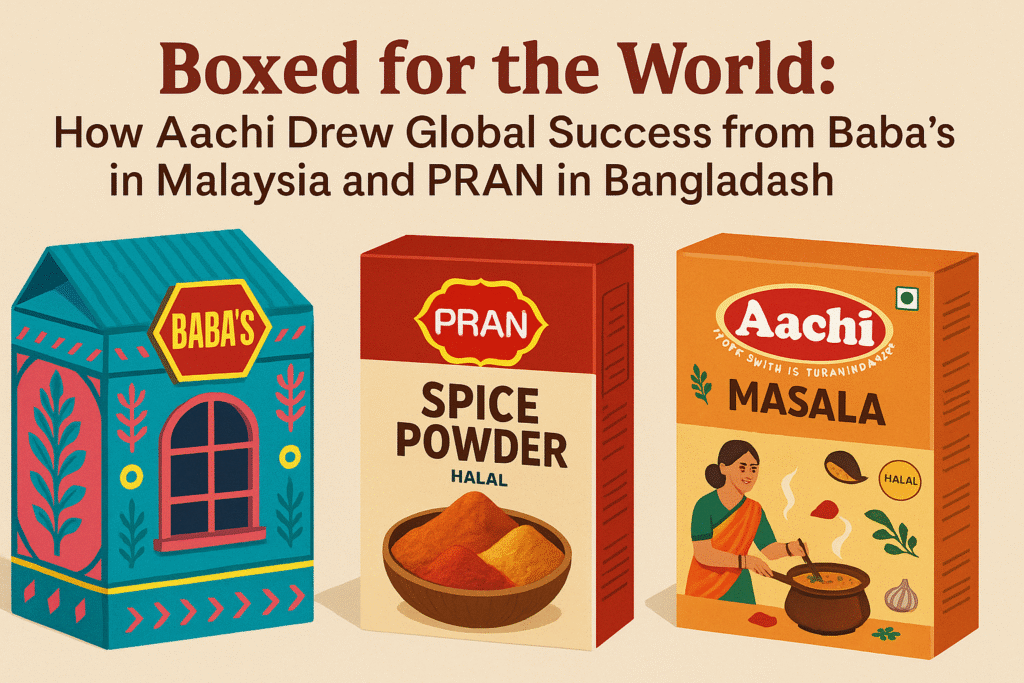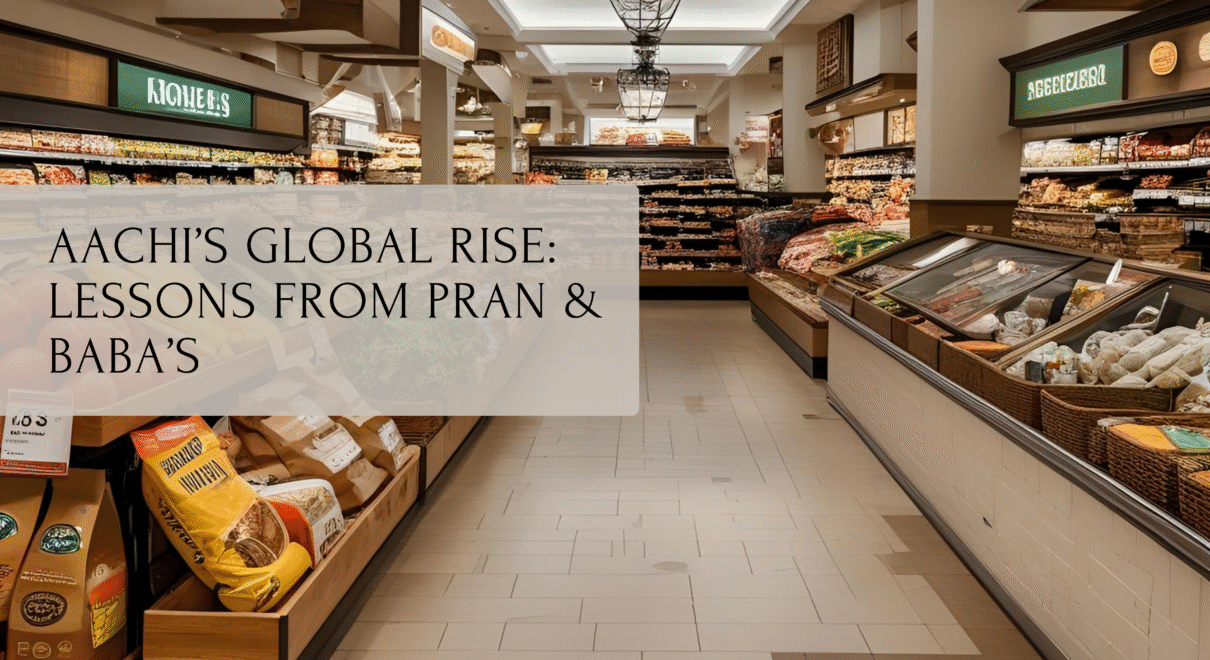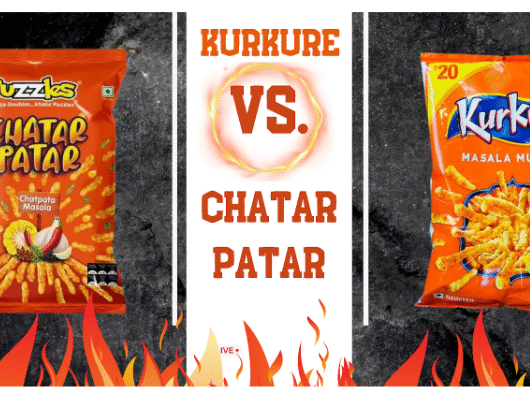
In a retail market where local brands are strong and trusted, only a few companies have dared to do things differently—by connecting with the local culture, using unique packaging, and building consumer trust. One such brand is Aachi, a South Indian food company that started small and local but eventually grew into an internationally known name.
So, what helped Aachi grow beyond India? The key lies in how Aachi learned from brands like Baba’s from Malaysia and PRAN from Bangladesh—especially how these brands used packaging and cultural identity to win over customers.
Aachi took inspiration from these successful Asian brands by following the idea of “Be Local, Go Global.” This helped Aachi enter international markets like Malaysia and Bangladesh and extend to 65 countries. The brand smartly adapted to local cultures while still staying true to its South Indian roots and identity.
Chapter 1: The Success of Baba’s – Malaysia’s Spice Giant
The journey begins with Baba Brand, more widely known as BABA’S, a Malaysian powerhouse in the world of spices and food ingredients. Originally starting as a small perfume shop, BABA’S transformed into a household name, known for its authentic curry powders, chili powders, and a wide array of food products.
What made Baba’s special wasn’t just the blend of spices—it was the way they presented the brand.
- Colors that pop: Bright blues, pinks, and yellows adorn the boxes, reflecting celebration and festivity.
- Interactive boxes: Some packages even include openable doors and windows, making them feel more like keepsakes than just containers.
- Modern meets traditional: While the boxes echo heritage, their corrugated structure and custom design features reflect innovation.
This packaging innovation became a silent salesman—conveying quality, tradition, and trust at every touchpoint.
Chapter 2: PRAN – Bangladesh’s FMCG Powerhouse
Next is PRAN, one of Bangladesh’s most powerful international brands. Founded in 1981, PRAN has grown to a multi-billion-dollar company and exports to more than 145 countries. From juices to biscuits to noodles to spices — PRAN’s extensive range is unrivaled in its range and global scale.
Like Baba’s, PRAN understood that package is identity:
- Boxed spices with consistency: PRAN spices are mainly boxed spices with a well-associated standardization to aid visibility and stack friendliness as boxed spices in stores, including South Asian grocery stores in Malaysia.
- Mass trust: PRAN had become the brand in use by Bangladeshi migrant communities abroad, as a result of loudly and readable product names, halal labeling, and batch level transparency in communications.
- Farming merging: The PRAN brand was very clearly aligned to fresh produce and fair trade as PRAN had begun purchasing food directly from Bangladeshi farmers, thereby creating sustainable branding attraction to ethical consumers in the world.
PRAN’s international packaging was not glam, it was deliberate, efficient and consistent. Their philosophy was simple — to trust in a box.
Chapter 3: Aachi’s Rise – Learning from the Region
Enter Aachi, an Indian brand from Tamil Nadu, founded in 1995 by A.D. Padmasingh Isaac. Aachi, which means “grandmother” in Tamil, was launched to deliver authentic South Indian flavors to every household. Within two decades, it expanded to over 65 countries, including strongholds in Malaysia and Bangladesh.
But the road wasn’t easy.
Early on, Aachi struggled to stand out in local markets filled with popular brands like PRAN, BABA’S. What changed the game was packaging innovation inspired by its regional counterparts.
- Localized box packaging: Learning from Baba’s and PRAN, Aachi began to invest in box-style spice packaging that mirrored the convenience and emotional appeal consumers were used to.
- Cultural imagery: Aachi’s packs began to feature traditional Tamil cooking scenes, local ingredients, and vibrant hues to evoke the flavor and feel of home.
- Compact and export-ready: The box format not only reduced shipping bulk but also aligned with shelf standards in international stores, making Aachi a favorite among the Indian diaspora and locals alike.
- Halal certification for Muslim markets: Just like Baba’s, Aachi understood the importance of halal labeling in Malaysia and Bangladesh and updated its product lines accordingly.
- Product mix localization: Aachi did not just export Indian products—it customized its blends for regional palates, such as milder curries for the Malaysian market and sweetened spice blends for Bangladesh.
Chapter 4: Packaging as a Brand Strategy
The stories of Baba’s, PRAN, and Aachi underscore a simple but powerful truth: packaging is not just design — it’s strategy.
Let’s break down how:
| Feature | BABA’S | PRAN | AACHI |
| Cultural Elements | Baba-Nyonya motifs, colorful homes | Bangla simplicity, trust symbols | Tamil culinary imagery |
| Packaging Format | Corrugated, colorful boxes | Uniform cardboard boxes | Export-ready boxed masalas |
| Certification | Halal certified | Halal certified | Halal + ISO certifications |
| Shelf Visibility | Vibrant, detailed graphics | Bold typography, product clarity | Color-coded product segmentation |
| Consumer Engagement | Interactive doors/windows | Simple packaging, consistent trust | Regional language + recipe info |
This packaging-centric approach allowed all three brands to win hearts before taste buds. For many first-time buyers, it’s the box that builds trust.
Chapter 5: Lessons for Indian Brands Entering Local Markets
For Indian brands, real growth isn’t always about going global. Sometimes, the bigger success lies in going local—understanding what people in each region want and giving them a product that feels familiar. Two key strategies help with this: packaging that blends in with local brands, and flavours that match local tastes.
Packaging That Feels Local
In every market, people trust what looks familiar. If a product looks like something they already use, they’re more likely to pick it up. That’s why packaging is so important.
Aachi understood this early on and paid close attention to what local shoppers expected to see on store shelves. It changed its packaging to match what people in those regions were used to seeing.
The box size, shape, design, and language were all adjusted to feel like a local brand. When packaging looks like it belongs on the same shelf as popular local products, it builds trust without saying a word.
Flavours That Match Local Taste
Taste is personal—and it changes from place to place. What people enjoy in South India may be very different from what they prefer in North India, Bangladesh, or Malaysia. That’s why flavour is just as important as packaging.
Spice levels, sweetness, and ingredient choices often need to be adjusted to match local food habits. Flavours that feel familiar create an instant connection and make the product more appealing.
When the taste matches what people are used to eating at home, it builds comfort, trust, and long-term loyalty—no advertising needed.
Conclusion
The journeys of Baba’s, PRAN, and Aachi reveal something powerful — success doesn’t only come from scale or reach. It comes from staying rooted, building trust through culture, and letting thoughtful packaging speak on behalf of the brand.
Aachi’s rise from a small spice brand in Tamil Nadu wasn’t a matter of luck. It was a result of observing what worked in its own region — from brands like Baba’s in Malaysia and PRAN in Bangladesh — and applying those lessons with care and creativity. Smart packaging, deep cultural understanding, and consistency were the driving forces.
For Indian businesses aiming to grow meaningfully, Aachi’s path serves as inspiration. Focus on your roots. Respect the traditions that shaped your product. And let every box you send out carry a story — your story.
If you’re a food entrepreneur, remember: the journey doesn’t start in a boardroom — it starts in the kitchen. Wrap your story in colour, fonts, flavours, and trust. That’s how a brand becomes more than a product — it becomes part of someone’s life.




